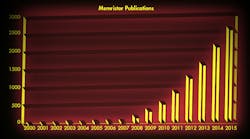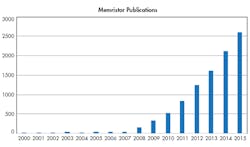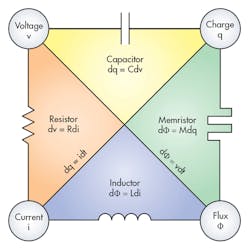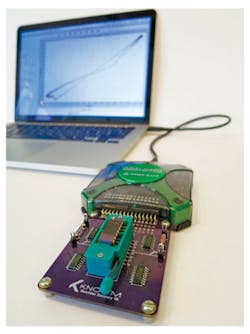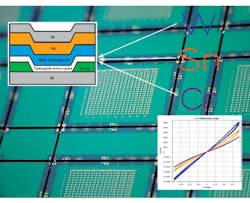This file type includes high-resolution graphics and schematics when applicable.
While semiconductors and software continue to expand the capabilities of electronics products, a new kind of passive component is breaking into the fast lane. The memristor (short for memory varistor, or memory resistor) has been called the fourth type of passive component, with memristive characteristics distinctly different from the familiar resistance, capacitance, and inductance. Memristors were first formalized in 1971, followed by announcement of some of the first commercial-intent devices in 2008, and more recent developments which we reveal here. It seems clear that you will be hearing more about the memristor.
Any new technology that begins to attract serious attention goes through a growth phase where research and development begins to take off, often entering a phase of logarithmic increase in activity. One quick and easy way to measure such trends is a search on keyword counts in publications and patents. After a slow start, the trends for the memristor seem to finally be entering a takeoff phase (Fig. 1).
We now see the emergence of a fresh approach to commercially available samples of these emerging passive-circuit devices. They promise to lead the way to some exciting future developments, including computing power that may rival the human brain, and applications that are as yet undiscovered.
About Memristors and Memristance
The three familiar passive R-C-L devices have been used for over a hundred years, while becoming increasingly specialized and miniaturized. The behavior of nonlinear devices, unlike conventional resistors, has also been part of the designer’s toolkit and holds future promise for new applications, as evidenced in prior Electronic Design articles. (see “Use Nonlinear Devices as Linchpins to Next Generation Design” and “Negative Differential Resistance Leads to Some Positive Results”).
Conceptually, the memristor is a nonlinear device that finally completes all of the basic relationships between voltage current, charge, and flux. Simply put, if resistors operate based on voltage and current, inductors on flux and current, and capacitors on voltage and charge, what about flux and charge? That’s the missing relationship completed by the memristor.
Figure 2 shows how the four passive elements relate. While the equations are oversimplified here, the key takeaway is that memristors bring into play the dynamic element of time, which defines flux. More on the theory that originated the memristive concept may be found in the seminal papers by Dr. Leon Chua.
Early Days
To better appreciate the emerging status of memristors, we offer this brief history.
In 1971, “Memristor—The Missing Circuit Element” (click for PDF) was published in IEEE Transactions on Circuit Theory by Dr. Chua. After years of scholarly research, including advances in nonlinear circuit theory, it was this paper in which he formally introduced the memristor. Additional supporting theory, models, characterization, equivalent circuits, and potential applications soon followed by Chua, co-workers, and others.
In the years following 1971, and probably before that milestone date as well, numerous reports and patents have surfaced on devices with bistable and switching behavior, which may or not have been truly memristive. Examples include phase change memory (PCM), magnetoresistance or “spintronics,” and various types of neural networks. Memristance had not yet, however, become recognized as a fundamental type of circuit behavior.
It was not until 2008 that mainstream electronics companies began to directly recognize memristive behavior as such. Among the most visible was the announcement by researchers from HP in the journal Nature, which got right to the point with this title: “The Missing Memristor Found” (click for PDF).
These devices were crossbar structures employing very thin (nanometer) layers of titanium dioxide. Their operation was described by a very useful analogy to the resistance of water flowing through a pipe: Depending on the prior rate of flow, the pipe remembers its condition when the water flow is turned off. In 2010, HP announced a partnership with Hynix to produce memristor memories, and in 2015, another with SanDisk. More recently, it’s not so clear how that commercialization is going, but it will be the subject of another story.
Coming of Age
Some of the mysteries surrounding memristors are beginning to be revealed as curious, but in fact, not so mysterious. In Chua and co-workers’ 2013 IEEE Circuits and Systems Magazine paper, entitled “The First Radios Were Made Using Memristors!” (click for abstract), they show how a simple “cat’s whisker” acting as a crude diode can exhibit basic memristive behavior.
This brings us to the present, and the availability of memristors that can be bought for evaluation. The parts are offered by the New Mexico-based startup company, Knowm. As I was speaking with Alex Nugent, CEO of Knowm, the similarity to the early days of the semiconductor revolution became apparent. When I was a curious young electronics hobbyist, I experienced the first wave of transistors first-hand. They had been invented before I was born, and had been commercialized in the 1960s in iconic products like radios and calculators. Kids could easily afford to buy a few discrete transistors for experiments. Coupled with a few resistors, capacitors, and inductors, hobbyists and students were able to build all kinds of radios, amplifiers, oscillators, and alarms.
We’re on the verge of a similar chapter today with the memristor; or more likely, many, many volumes of virtual books. Like the curiosity and thrill of early transistor-based circuits, the same excitement is there today with the memristor. Knowm’s devices are available for sampling now (Fig. 3). According to Nugent, some hundreds of their packaged memristor sample chips have been bought for evaluation. “We want to get the devices out there,” he explains.
An AHaH Moment
Nugent explained his early fascination, as a physics undergrad, with neural networks and adaptive synapses, which are so unlike the rigid mechanisms of computers. The influences of biology and nature are evident in his vision, embodied in the bifurcating energy-dissipation networks seen in the branches, leaves, and roots of plants; river tributaries and deltas; veins and arteries in animals; fungus; neurons, and even lightning.
His work led to the creation of the DARPA Systems of Neuromorphic Adaptive Scalable Electronics (SyNAPSE) program, a large-scale research effort to realize on-chip learning with memristors, which he co-created and advised with program manager Todd Hylton. An additional DARPA program called Physical Intelligence (PI) was launched, which he also advised, and it was during this time that some of the core principles of the Knowm concept were seeded.
In the same way as a lightning bolt searches the sky for ground, “eroding” (ionizing) conducting channels through the air, a new type of computing is possible where conducting channels “grow” from a memristor-enabled “growth substrate.” Along with Knowm partner Tim Molter, they proved that such growth mechanisms could be used in digital computing and machine-learning structures by connecting the underlying physical process of “energy dissipation pathways competing for conduction resources” with neural plasticity, self-repairing digital logic, and multiple branches of machine learning.
To understand the Knowm approach, we need to introduce Anti-Hebbian and Hebbian (AHaH) behavior. Donald Hebb was a neuropsychologist who studied how neurons enable us to learn. To oversimplify—more detail is available at http://knowm.org/ahah-computing/—the axon of one neuron will affect a neighboring dendrite of another neuron in a way that either facilitates state transfer (Hebbian or ‘positive feedback’) or inhibits it (anti-Hebbian or ‘negative feedback’).
In the same way as water flowing over ground causes it to erode, increasing the conductance of the river bed, a memristor will “erode” as current flows through it, increasing its electrical conductance. Suddenly, the applicability of memristors to adaptive machine learning became clear. Different states of conductance that are dynamic could become the basis for learning, as opposed to the limited, predetermined, and digitally computed binary states of today’s computing machines.
At the same time, this suggests how to solve another barrier preventing today’s computing architecture to reach the next level of performance. That is the need to constantly shuffle back and forth information between processor and memory, called the Von Neumann bottleneck. What if memory could also be, at the same time, the processor? This is how a brain works, which shows no distinctly separate memory or computing structures and could roughly be described as a “substrate for growing communication networks.” The promise of the memristor’s dynamic behavior is intriguing.
Get the Devices Out There
Today you can get a Knowm memristor—actually eight of them in a single ceramic DIP—to try for yourself. If you have the tools and experience, they also provide raw silicon die and CMOS integration services.
The sample parts are produced in collaboration with Dr. Kris Campbell at Boise State University’s Idaho Microfabrication Laboratory. Campbell is a physical chemist and electronic engineering professor who has developed alternate ways to fabricate memristors. Her earlier work included research on photosynthesis, where metal complexes transfer energy to the plant while releasing oxygen. It’s little wonder how a synergy with the nature-inspired approach of the Knowm Company developed. But there’s substance here besides a philosophical approach—these are real parts.
The Knowm devices are based on a different material than those from HP, instead being built with a metallized glass. They begin with a special type of chalcogenide glass using selenium, one of the elements in group 16 under oxygen in the periodic table. The glass is further comprised of the familiar semiconductor, germanium.
Using conventional semiconductor thin-film sputtering equipment, additional metal layers of tin selenide and silver are deposited on top of the glass. Top and bottom contacts are made using tungsten. The fabrication approach is described as being relatively straightforward, with no unusual process controls required to achieve repeatable performance.
In practical operation, the devices show a repeatable write and read cycle that has been estimated to be reliable through a billion operations. Furthermore, they’re stable in high-temperature environments (see Campbell’s technical paper). Current-voltage sweeps verify that these devices have the nonlinear “bow tie” characteristics of true memristive behavior (Fig. 4).
The many possible applications for memristors have yet to be defined, and a new type of memory is just one of them. Knowm memristors have already been demonstrated in more exotic applications like ultrasonic transducers. Think of it this way: Presented with a traditional passive component, what would you do with it? Imagination, creativity, and an open mind are the keys, and the possibilities are wide open. It’s important not to try to use a memristor in some preconceived way. In this time of rapid development, we look forward to seeing what happens next with memristors in growing numbers on the benches of inquisitive engineers.
